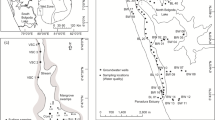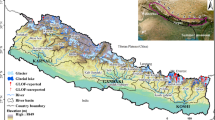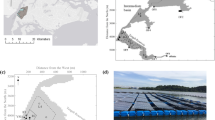Abstract
In recent years, a number of workers have studied the stability of deep lakes such as Lake Tanganyika, Lake Baikal and Lake Malawi. In this paper, the methods that can be used to determine the effect that the components of lakes have on the equation of state are examined. The PVT properties of Lakes have been determined by using apparent molal volume data for the major ionic components of the lake. The estimated PVT properties (densities, expansibility and compressibilities) of the lakes are found to be in good agreement with the PVT properties (P) of seawater diluted to the same salinity. This is similar to earlier work that showed that the PVT properties of rivers and estuarine waters could also be estimated from the properties of seawater.
The measured densities of Lake Tanganyika were found to be in good agreement (± 2 × 10-6 g cm-3) with the values estimated from partial molal properties and the values of seawater at the same total salinity (ST = 0.568‰). The increase in the densities of Lake Tanganyika waters increased due to changes in the composition of the waters. The measured increase in the measured density (45 × 10-6 g cm-3) is in good agreement (46 × 10-6 g cm-3) with the values calculated for the increase in Na+, HCO3 -, Mg2+, Ca2+ and Si(OH)4.
Methods are described that can be used to determine the conductivity salinity of lakes using the equations developed for seawater. By combining these relationships with apparent molal volume data, one can relate the PVT properties of the lake to those of seawater.
Similar content being viewed by others
References
Brewer, G. and Bradshaw, A. (1975) The effect of non-ideal composition of seawater on salinity and density, J.Mar.Res. 33, 157–175.
Callender, E. and Granina, L. (1997) Geochemical mass balances of major elements in Lake Baikal, Limnol. Oceanogr. 42, 148–155.
Chen, C. T. and Millero, F. J. (1977) Effect of salt content on the temperature of maximum density and on static stability in Lake Ontario, Limnol. Oceanogr. 22, 158.
Degens, E. T., Von Herzen, R. P. and Wong, H-K. (1971) Lake Tanganyika: Water chemistry, sediments, geological structure, Naturwissen 58, 229.
Edmond, J. (1974) Lake Chemistry, Sect. IV, in Lake Tanganyika Geochemical and Hydrographic Study (ed. H. Craig), SIO Ref. Ser. 75–5, University of California at San Diego, 64 pp.
Effler, S.W., Schimel, K. and Millero, F. J. (1986) Salinity, ionic strength, and chloride relationships in ion polluted Onondaga Lake N.Y. Water, Air, Soil Pollution 27, 169–180.
Falkner, K. K., Measures, C. I., Herbelin, S. E., Edmond, J. M. and Weiss, R.F. (1991) The major and minor element geochemistry of Lake Baikal, Limnol.Oceanogr.36, 413–423.
Hill, K. D., Dalphinee, T. M. and Woods, D. J. (1986) The extension of the Practical Salinity Scale 1978 to low salinities, IEEE J. Oceanic Eng., OE-11, 109.
Jellison, R., Macintyre, S. and Millero, F. J. (1999) Density and conductivity properties of Na-CO3-Cl-SO4 brine, Int.J.Salt Lake Res., in press.
Kell, G. S. (1967) Precise representation of volume properties of water at one atmosphere, J.Chem.Eng.Data 12, 66–69.
Kell, G.S. (1970) Isothermal compressibility of liquid water at one atmosphere, J.Chem.Eng.Data 15, 119–122.
Lepple, F. K. and Millero, F. J. (1971) The isothermal compressibility of seawater near one atmosphere, Deep-Sea Res.18, 1233–1254.
Mcmanus, J., Collier, R. W., Chen, C. A. and Dymond, J. (1992) Physical properties of Crater Lake, Oregon: A method for the (1993) determination of a conductivity-and temperature-dependent expression for salinity, Limnol.Oceanogr.37, 41–53.
Millero, F. J. (1973a) Theoretical estimates of the isothermal compressibility of seawater, Deep-Sea Res.20, 101–105.
Millero, F. J. (1973b) Seawater-a test of multicomponent electrolyte solution theories. I. The apparent equivalent volume, expansibility and compressibility of artificial seawater, J.Solution Chem. 2, 1–22.
Millero, F. J. (1974) Seawater as a multicomponent electrolyte solution. In: The Sea(ed. E. Goldberg), Wiley, New York, pp. 3–80.
Millero, F. J. (1975) The physical chemistry of estuaries, Chapter 2, In: Marine Chemistry in the Coastal Environment(ed. T. M. Church), ACS Symp. Ser. 18, Washington D.C., pp. 25–55.
Millero, F. J. (1982) The thermodynamics of seawater. Part 1. The PVT properties, Ocean Sci.and Eng.7, 403–460.
Millero, F. J. (1984) The conductivity-density-salinity-chlorinity relationship for estuarine waters. Limnol.Oceanogr.29, 1317–1321.
Millero, F. J. (1996) Chemical Oceanography, CRC Press, Boca Raton, FL, 469 pp.
Millero, F. J. (1999) The Physical Chemistry of Natural Waters, Wiley Scientific, N.Y., in press.
Millero, F. J. and Lepple, F. K. (1973) The density and expansibility of artificial seawater solutions from 0 to 40_C and 0 to 21hchlorinity, Marine Chem.1, 89–104.
Millero, F. J. and Chetirkin, P. V. (1980) The density of Caspian Sea waters. Deep-Sea Res.27, 265–271.
Millero, F.J. and Poisson, A. (1981) International one-atmosphere equation of state of seawater. Deep-Sea Res.28, 625–629.
Millero, F. J., Perron, G. and Desnoyers, J. E. (1973a) Heat capacity of seawater solutions from 5 to 35_C and 0.5 to 22hchlorinity, J.Geophys.Res.78, 4499–4507.
Millero, F. J., Hansen, L. D. and Hoff, E. V. (1973b) The enthalpy of seawater from 0 to 30_C and 0 to 40hsalinity, J.Mar.Res.31, 21–39.
Millero, F. J., Lawson, D., and Gonzalez, A. (1976a) The density of artificial river and estuarine waters, J.Geophys.Res.81, 1177–1179.
Millero, F. J., Gonzalez, A., Brewer, P. G., and Bradshaw, A. (1976b) The density of North Atlantic and North Pacific deep waters, Earth & Planet.Sci.Lett. 32, 468–472.
Millero, F. J., Ward, G. K., and Chetirkin, P. V. (1977) Relative sound velocities of sea salts at 25_C. J.Acoust.Soc.Am.61, 1492–1498.
Millero, F. J., Rico, J., and Schreiber, D. R. (1982a) PVT properties of concentrated aqueous electrolytes. II. Compressibilities and apparent molar compressibilities of aqueous NaCl, Na2SO2, MgCl2, andMgSO4 from dilute solution to saturation and from 0 to 50_C. J.Solution Chem.11, 671–686.
Millero, F. J., Mucci, A., Zullig, J., and Chetirkin, P. (1982b) The density of Red Sea brines. Mar. Chem.11, 463–475.
Millero, F. J., Chen, C.-T., Bradshaw, A., and Schleicher, K. (1980) A new high pressure equation of state for seawater, Deep-Sea Res.27, 255–264.
Picker, P. Tremblay, E., and Jolicoeur, C. (1974) A high-precision digital readout flow densimeter for liquids, J.Solution Chem.3, 377–384.
Robinson, R. A. and Stokes, R. H. (1959) Electrolyte Solutions, 2nd ed., Butterworths, London, 455 pp.
Sorensen, J. A. and Glass, G. E. (1987) Ion and temperature dependence of electrical conductance for natural waters, Anal.Chem.59, 1594–1597.
UNESCO (1981) Background papers and supporting data on the Practical Salinity Scale, 1978, UNESCO Tech. Pap. Mar. Sci. 37, 144 pp.
Wüest, A., Piepke, G., and Halfman, J. D. (1996) Combined effects of dissolve solids and temperature on the density tratification of Lake Malawi. In: The Limnology, Climatology and Paleoclimatology of the East African Lakes(eds. T. C. Johnson and E. O. Odada), Gordon and Breach Scientific Pubs., pp. 183–202.
Young, T. F. and Smith, M. B. (1954) Thermodynamic properties of mixtures of electrolytes in aqueous solutions, J.Phys.Chem.58, 716–724.
Author information
Authors and Affiliations
Rights and permissions
About this article
Cite this article
Millero, F.J. The Equation of State of Lakes. Aquatic Geochemistry 6, 1–17 (2000). https://doi.org/10.1023/A:1009626325650
Issue Date:
DOI: https://doi.org/10.1023/A:1009626325650




